Hierarchical Wireless Multimedia Sensor Networks for Collaborative Hybrid Semi-Supervised Classifier Learning
Abstract
:1. Introduction
2. Preliminaries
3. TSVM Based Target Classification
3.1 The principle of classical SVM
3.2 TSVM training with unlabeled samples
| Procedure TSVM Algorithm |
| 1. Initialization |
| Specify the parameter C and C* |
| Execute an initial learning using all labeled samples, and produce an initial classifier |
| Specify a number N as the estimated number of unlabeled samples which will be positive-labeled |
| 2. Assign label for the unlabeled samples |
| Compute the decision function values of all the unlabeled samples with the initial classifier. |
| Label N samples with the largest decision function values as positive, and the others as negative. |
| Set a temporary effect factor . |
| Repeat |
| 3. Retrain the SVM classifiers |
| Repeat |
| Retrain the SVM classifiers over all labeled samples. |
| Use new SVM classifiers to classify all the unlabeled samples. |
| Switch labels of one pair of different-labeled unlabeled samples using a certain rule to make the value of the objective function in (11) decrease as much as possible. |
| Until no pair of samples satisfying the switching condition is found. |
| 4. Adjust the value of |
| Increase the value of slightly |
| Until |
4. Collaborative SVM Learning Method
4.1 Centralized learning paradigm
4.2 Distributed learning paradigm
4.2.1 Distributed client/server learning paradigm
4.2.2 Distributed mobile agent learning paradigm
4.3 Collaborative hybrid learning paradigm
4.3.1 The overview of collaborative hybrid learning paradigm
4.3.2 Ant optimization routing for collaborative hybrid learning
| Procedure ACO Based Routing and Clustering in WMSNs |
| 1. Initialization |
| Initialize the pheromone of lines between all sensor nodes, τij (i, j = 1,2,…, n) |
| Initialize the ant colony which contains k groups of ants. And each group consists of m ants. |
| Repeat |
| 2. Assign the number of sensor nodes to every ants |
| For each group i∈[1,…,k] and each ant j∈[1,…,m]: |
| Randomly select a sensor node as starting sensor nodes for current ant. |
| Randomly assign a number of sensor nodes, , to jth ant in ith group. |
| Endfor |
| 3. Route Selection |
| For each group i∈[1,…,k] and each ant j∈[1,…,m]: |
| If the number of sensor nodes in sub-tour list is less than |
| Then generate the probability of potential routes by Eq. (29) and select the next sensor node |
| Else current ant returns to its starting sensor node |
| EndIf |
| Endfor |
| 4. Pheromone Updating |
| For each group i∈[1,…,k]: |
| Calculate the total distance, , accessed by current group of ants. |
| Endfor |
| Find the optimal group of ants with the smallest |
| Update the pheromone by Eq. (32) and Eq. (33) |
| Until stopping condition is satisfied (usually when the number of iterations reaches a predefined threshold, or when the best solution does not update for a certain number of iterations.) |
| 5. Output results |
| Output the routing and clustering results indicated by current best solution |
5. Experiments
5.1 Simulated routing and clustering experiments
5.2 Real world target classification experiments
6. Conclusions
Acknowledgments
Appendix A
Appendix B
References and Notes
- Akyildiz, I. F.; Melodia, T.; Chowdhury, K. R. A survey on wireless multimedia sensor networks. Computer Networks 2007, 51, 921–960. [Google Scholar]
- Duarte, M. F.; Hu, Y. H. Vehicle classification in distributed sensor networks. Journal of Parallel and Distributed Computing 2004, 64, 826–838. [Google Scholar]
- Flouri, K.; Beferull-Lozano, B.; Tsakalides, P. Training a SVM-based classifier in distributed sensor networks. Proc. 14nd European Signal Processing Conference; 2006; pp. 1–5. [Google Scholar]
- Wang, X.; Wang, S.; Bi, D.; Ma, J. Distributed peer-to-peer target tracking in wireless sensor networks. Sensors 2007, 7, 1001–1027. [Google Scholar]
- Shilton, A.; Palaniswami, M.; Ralph, D.; Tsoi, A. Incremental training of support vector machines. IEEE Trans. Neural Networks 2005, 16, 114–131. [Google Scholar]
- Rüping, S. Incremental learning with support vector machines. Proc. IEEE Int. Conf. on Data Mining; 2001; pp. 641–642. [Google Scholar]
- Joachims, T. Transductive inference for text classification using support vector machines. International Conference on Machine Learning; 1999; pp. 200–209. [Google Scholar]
- Wang, X.; Wang, S. Collaborative signal processing for target tracking in distributed wireless sensor networks. Journal of Parallel and Distributed Computing 2007, 67, 501–515. [Google Scholar]
- Haritaoglu, I.; Harwood, D.; Davis, L. S. W4: real-time surveillance of people and their activities. IEEE Trans. Pattern Recognition and Machine Intelligence 2000, 22, 809–830. [Google Scholar]
- Sweldens, W. The lifting scheme: a custom-design construction of biorthogonal wavelets. Applied and Computational Harmonic Analysis 1996, 3, 186–200. [Google Scholar]
- Martina, M.; Masera, G.; Piccinini, G.; Vacca, F.; Zamboni, M. Embedded IWT evaluation in reconfigurable wireless sensor network. The 9th International Conference on Electronics, Circuits and Systems; 2002; pp. 855–858. [Google Scholar]
- Chen, Y.; Wang, G.; Dong, S. Learning with progressive transductive support vector machine. Pattern Recognition Letters 2003, 24, 1845–1855. [Google Scholar]
- Liao, D.; Jiang, B.; Wei, X. Fast learning algorithm with progressive transductive support vector machine. System Engineering and Electronics 2007, 29, 88–91. [Google Scholar]
- Wang, X.; Wang, S.; Ma, J. An improved co-evolutionary particle swarm optimization for wireless sensor networks with dynamic deployment. Sensors 2007, 7, 354–370. [Google Scholar]
- Xu, Y.; Qi, H. Distributed computing paradigms for collaborative signal and information processing in sensor networks. Journal of Parallel and Distributed Computing 2004, 64, 945–959. [Google Scholar]
- Rahman, Md. A.; Miah, Md. S.; Gueaieb, W.; Saddik, A. SENORA: a P2P service-oriented framework for collaborative multirobot sensor networks. IEEE Sensor Journal 2007, 7, 658–666. [Google Scholar]
- Patwari, N.; Ash, J. N.; Kyperountas, S.; Hero, A. O.; Moses, R. L.; Correal, N. S. Locating the nodes: cooperative localization in wireless sensor networks. IEEE Signal Processing Magazine 2005, 22, 54–69. [Google Scholar]
- Wang, X.; Wang, S. Peer-to-Peer collaborative signal processing for target tracking in wireless sensor networks. Fifth International Conference on Grid and Cooperative Computing; 2006; pp. 160–163. [Google Scholar]
- Kant, K.; Iyer, R.; Tewari, V. A framework for classifying peer-to-peer technologies. The 2nd IEEE/ACM International Symposium on Cluster Computing and the Grid; 2002; pp. 1–8. [Google Scholar]
- Wu, Q.; Rao, N. S. V.; Barhen, J.; Iyengar, S. S.; Vaishnavi, V. K.; Qi, H.; Chakrabarty, K. On computing mobile agent routes for data fusion in distributed sensor networks. IEEE Trans. Knowledge and Data Engineering 2004, 16, 740–753. [Google Scholar]
- Wang, X.; Ma, J.; Wang, S.; Bi, D. Cluster-based dynamic energy management for collaborative target tracking in wireless sensor networks. Sensors 2007, 7, 1193–1215. [Google Scholar]
- Bektas, T. The multiple traveling salesman problem: an overview of formulations and solution procedures. Omega 2006, 34, 209–219. [Google Scholar]
- Somhom, S.; Modares, A.; Enkawa, T. Competition-based neural network for the multiple travelling salesmen problem with minmax objective. Computers & Operations Research. 1999, 26, 395–407. [Google Scholar]
- Song, C.; Lee, K.; Lee, W. D. Extended simulated annealing for augmented TSP and multi-salesmen TSP. Proceedings of the international joint conference on neural networks; 2003; 3, pp. 2340–2343. [Google Scholar]
- Sofge, D.; Schultz, A.; De Jong, K. Evolutionary computational approaches to solving the multiple traveling salesman problem using a neighborhood attractor schema. Lecture notes in computer science 2002, 2279, 151–160. [Google Scholar]
- Dorigo, M.; Gambardella, L. M. Ant colony system: a cooperative learning approach to the traveling salesman problem. IEEE Trans. Evolutionary Computation 1997, 1, 53–66. [Google Scholar]
- Pan, J.; Wang, D. An ant colony optimization algorithm for multiple travelling salesman problem. First International Conference on Innovative Computing, Information and Control; 2006; 1, pp. 210–213. [Google Scholar]
- Rosenkrantz, D. J.; Stearns, R. E.; Lewis, P. M. An analysis of several heuristics for the traveling salesman problem. SIAM Journal on Computing 1977, 6, 563–581. [Google Scholar]
- Sim, K. M.; Sun, W. H. Ant colony optimization for routing and load-balancing: survey and new directions. IEEE Trans. on Systems, Man and Cybernetics, Part A 2003, 33, 560–572. [Google Scholar]
- Iyengar, S. S.; Wu, H.-C.; Balakrishnan, N.; Chang, S. Y. Biologically inspired cooperative routing for wireless mobile sensor networks. IEEE Systems Journal 2007, 1, 29–37. [Google Scholar]
- Lee, S.; Crawford, M. M. Unsupervised classification for multi-sensor data in remote sensing using Markov random field and maximum entropy method. Proceedings of IEEE International Geoscience and Remote Sensing Symposium; 1999; 2, pp. 1200–1202. [Google Scholar]
- Wang, L.; Ji, H.; Gao, X. Clustering based on possibilistic entropy. Proceedings of 7th International Conference on Signal Processing; 2004; 2, pp. 1467–1470. [Google Scholar]
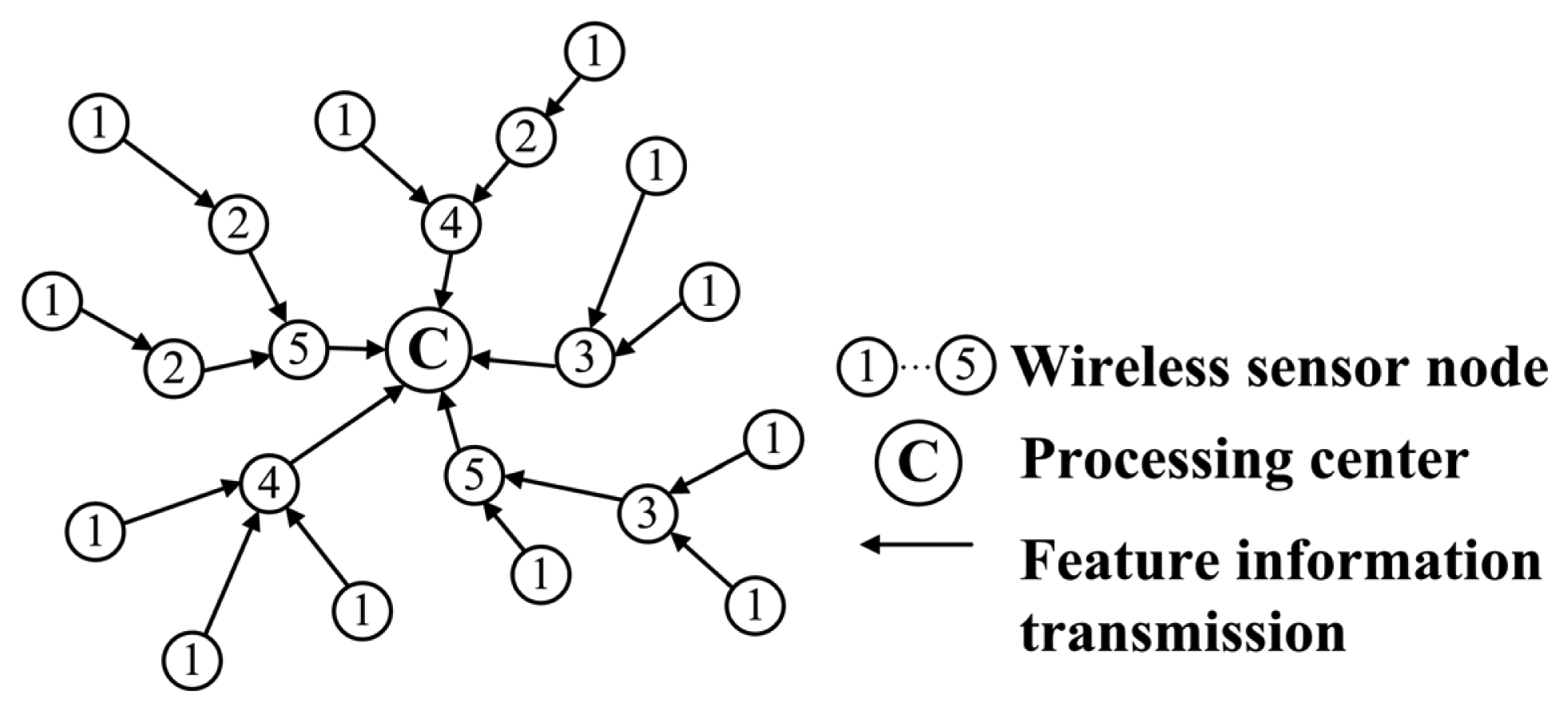
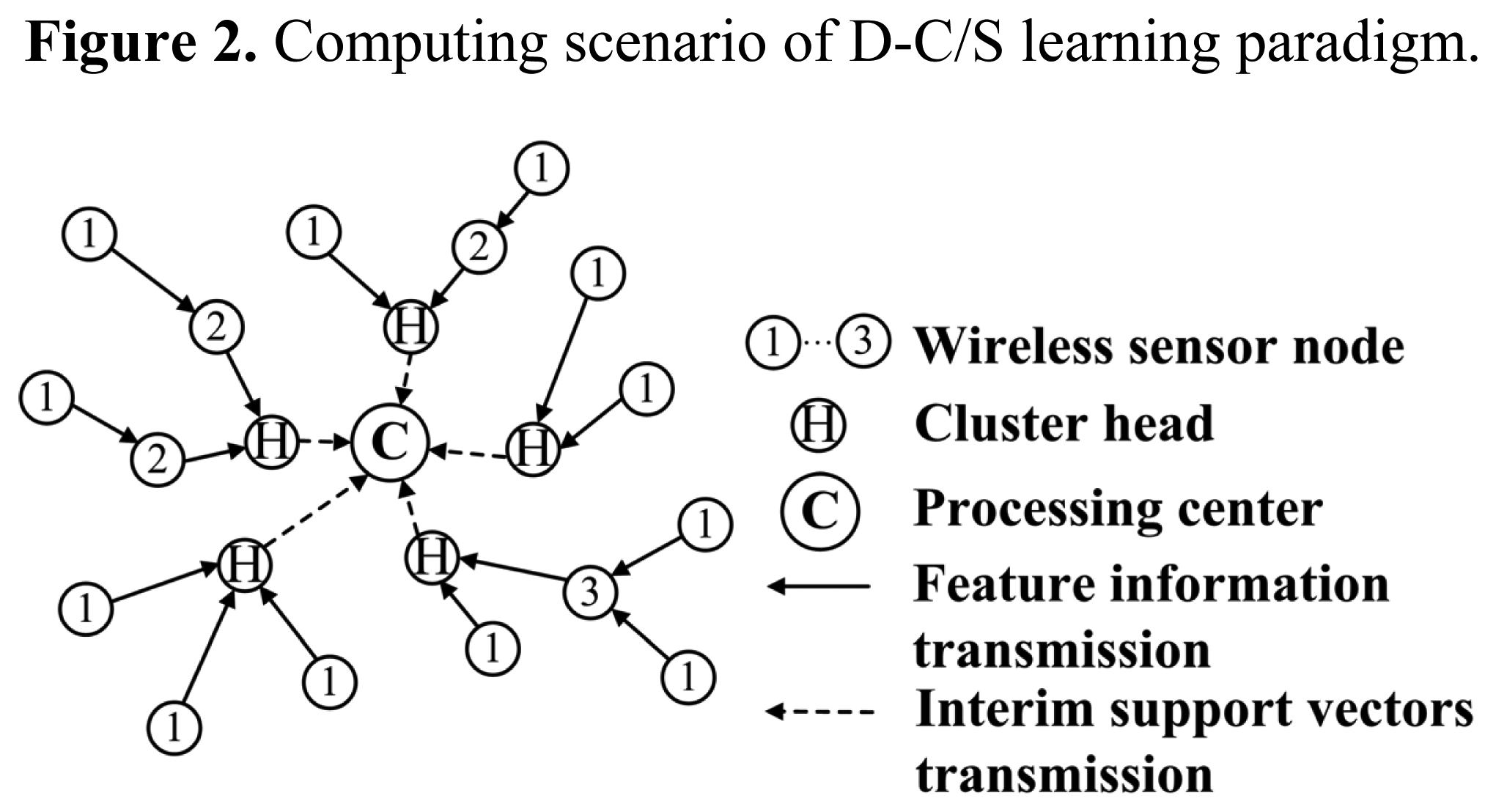
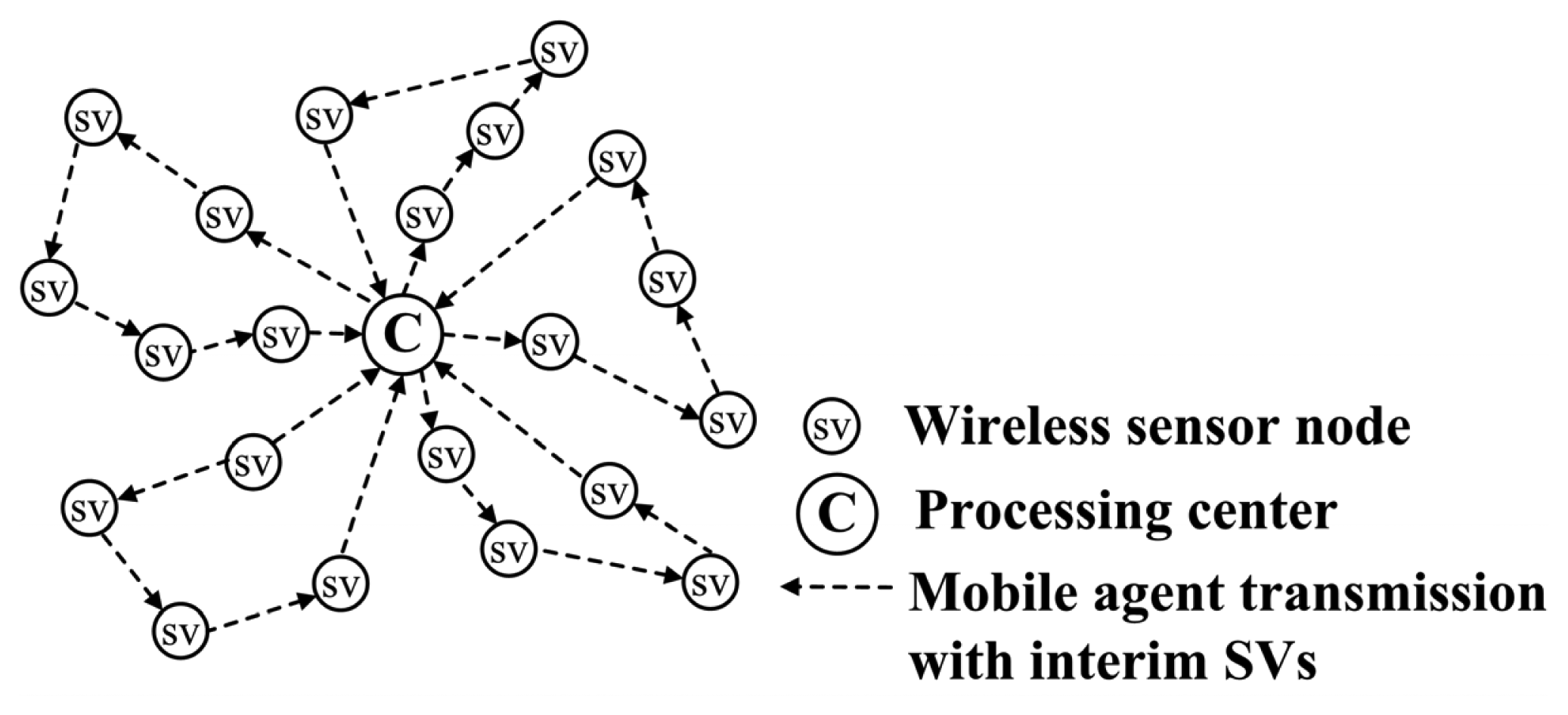

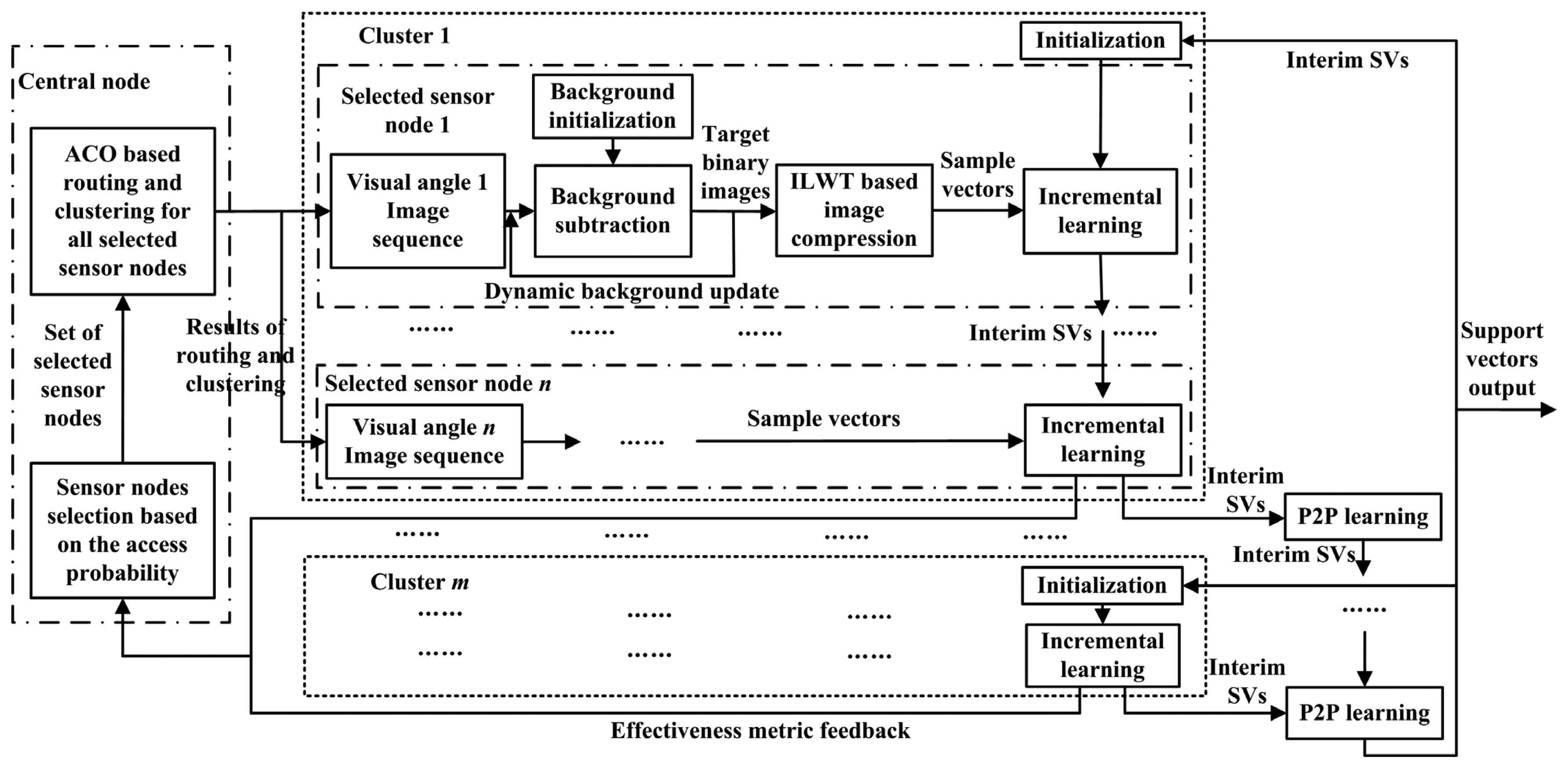
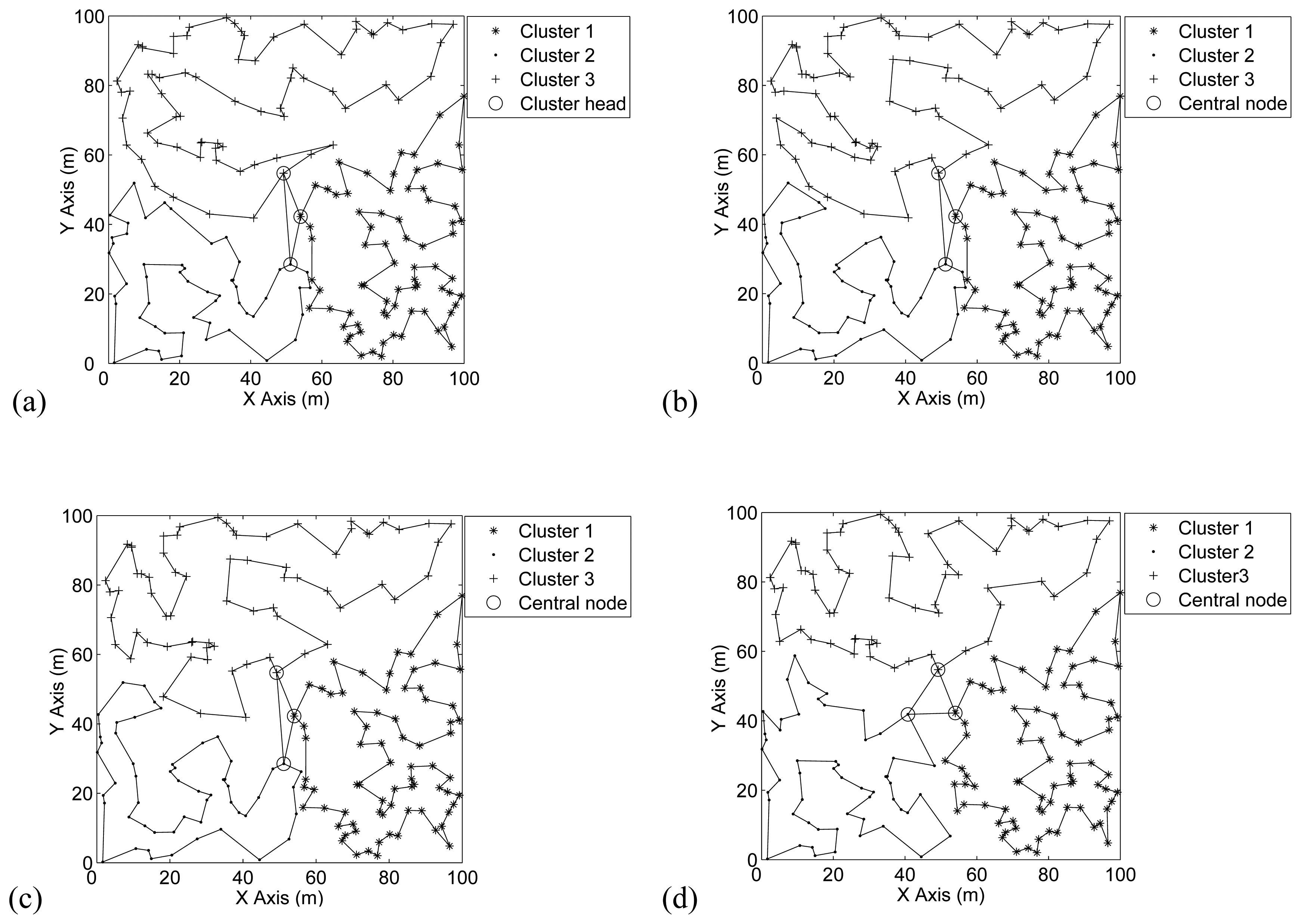
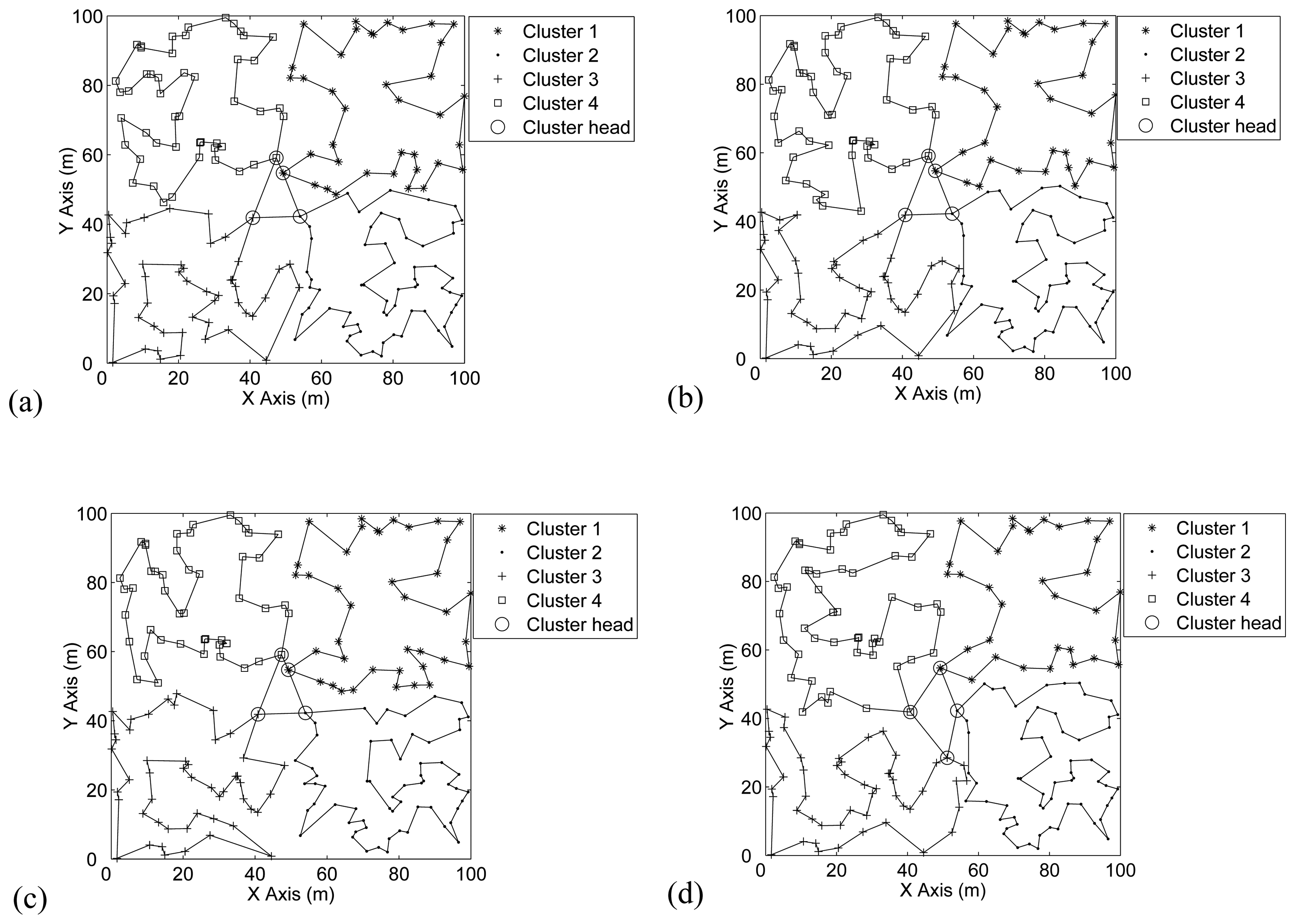


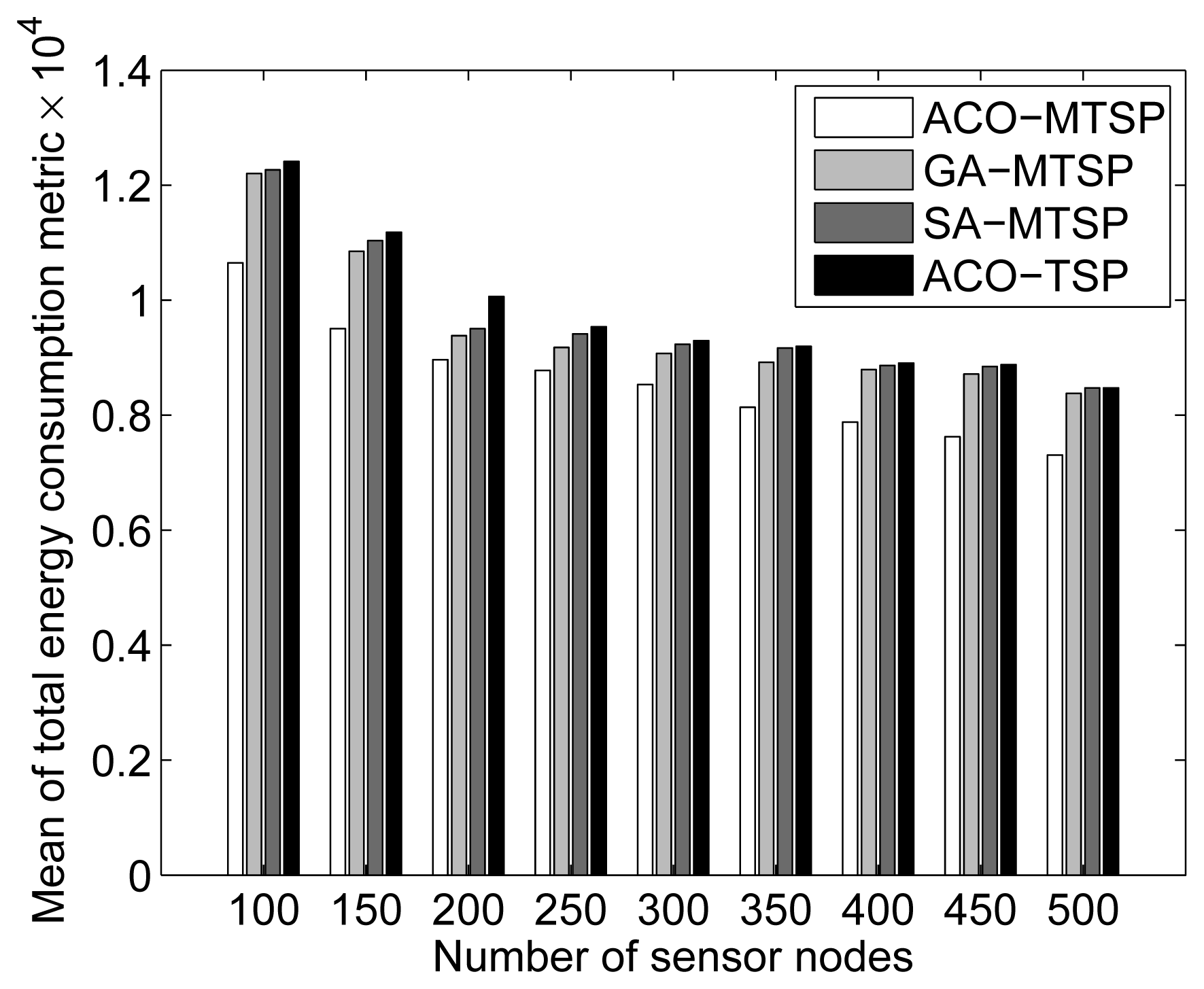
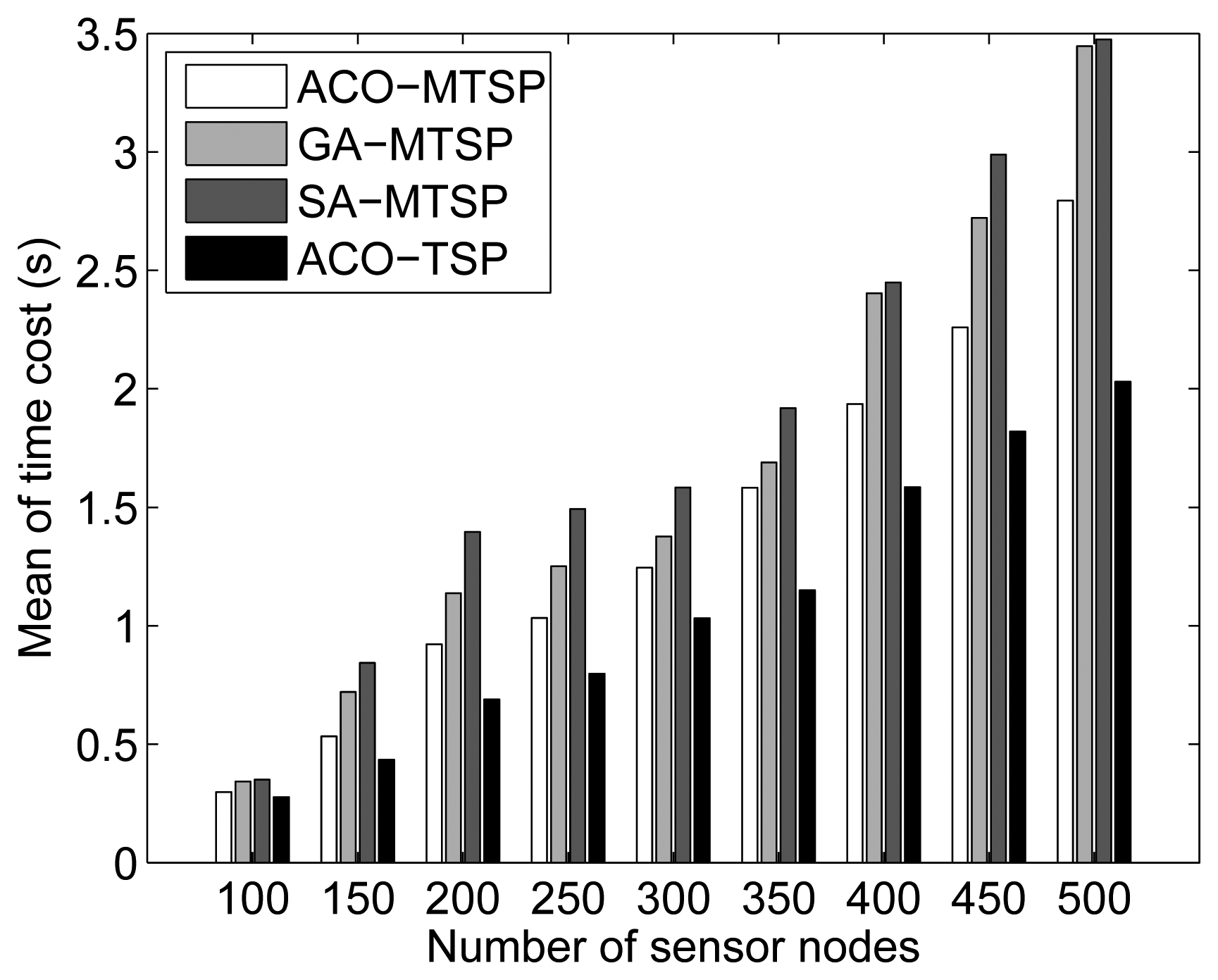
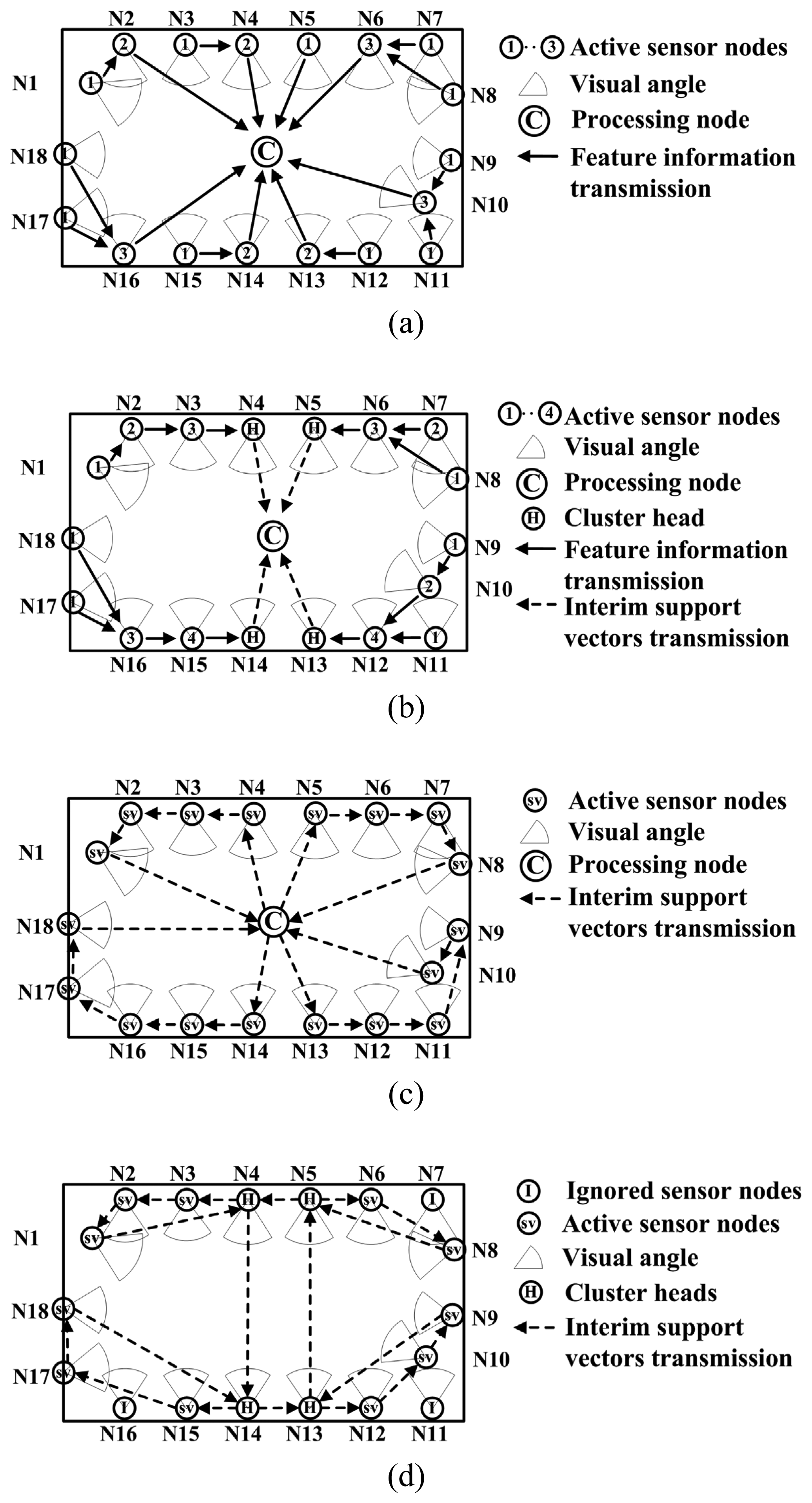
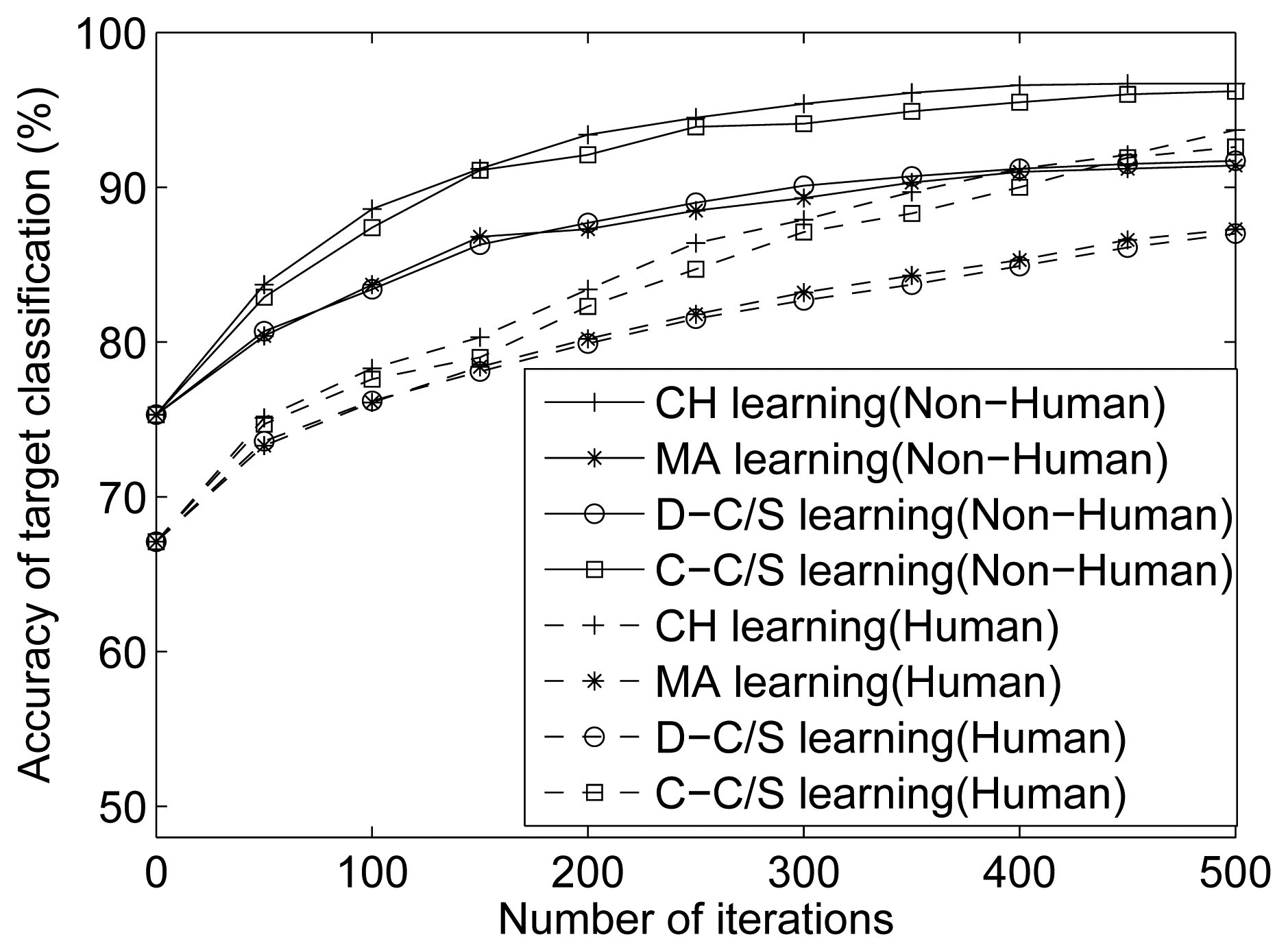

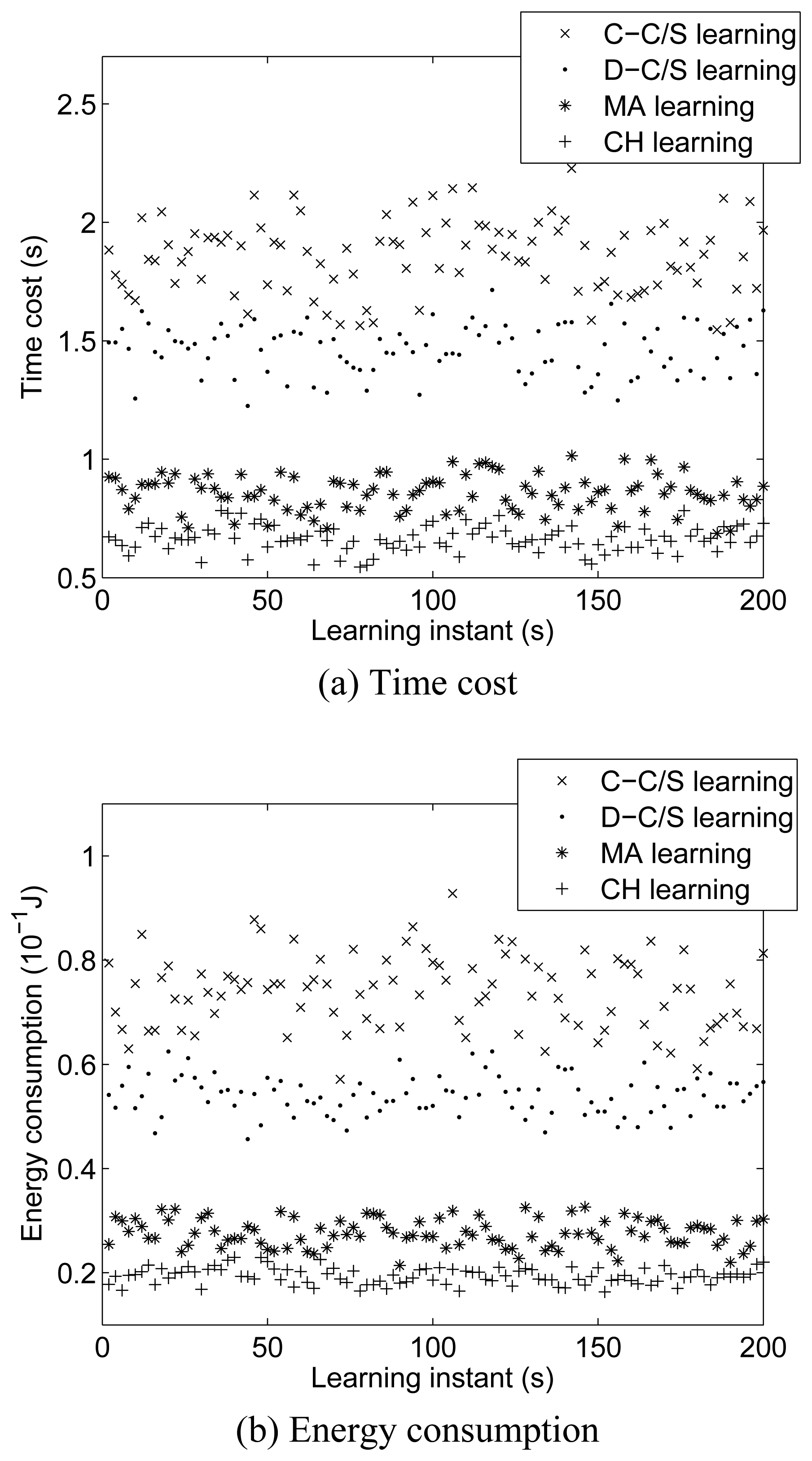
2007 by MDPI ( http://www.mdpi.org). Reproduction is permitted for noncommercial purposes.
Share and Cite
Wang, X.; Wang, S.; Bi, D.; Ding, L. Hierarchical Wireless Multimedia Sensor Networks for Collaborative Hybrid Semi-Supervised Classifier Learning. Sensors 2007, 7, 2693-2722. https://doi.org/10.3390/s7112693
Wang X, Wang S, Bi D, Ding L. Hierarchical Wireless Multimedia Sensor Networks for Collaborative Hybrid Semi-Supervised Classifier Learning. Sensors. 2007; 7(11):2693-2722. https://doi.org/10.3390/s7112693
Chicago/Turabian StyleWang, Xue, Sheng Wang, Daowei Bi, and Liang Ding. 2007. "Hierarchical Wireless Multimedia Sensor Networks for Collaborative Hybrid Semi-Supervised Classifier Learning" Sensors 7, no. 11: 2693-2722. https://doi.org/10.3390/s7112693
APA StyleWang, X., Wang, S., Bi, D., & Ding, L. (2007). Hierarchical Wireless Multimedia Sensor Networks for Collaborative Hybrid Semi-Supervised Classifier Learning. Sensors, 7(11), 2693-2722. https://doi.org/10.3390/s7112693




